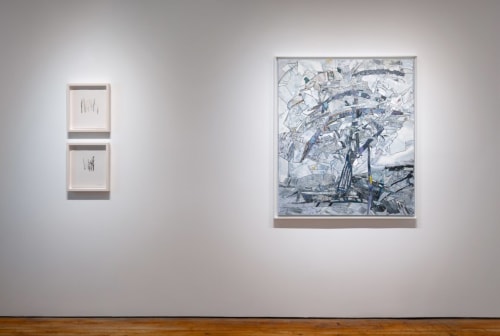
Gallery Round-Up: Building and Breaking from Traditions, Three Exhibitions Offer Intimate Material Explorations
By: Fanni Somogyi
Natural Motifs Abound in Solo Shows at Goya Contemporary and Galerie Myrtis, as well as at C. Grimaldis' Group Sculpture Show
Trace Miller: Pulp Fiction at Goya Contemporary
What do trees dream of through their winter slumber? These somber giants are filled with a capacity to care for and nurture one another through root systems. These thoughts enter my mind as I peruse Trace Miller’s collages and paintings of trees and forests in his new exhibition, Pulp Fiction, curated by Amy Eva Raehse, at Goya Contemporary. While most works are collaged paper pulp, pushed, formed, and pressed, while other works also include acrylic and oil paint.
There is a level of abstraction in the works with trees observed, simplified, and reconstructed into thick, rough lines. The linear forms are gestural and flat honing the focus onto the surfaces. I’m intrigued by how the subject matter is also the source of the material, and it feels like a celebration of matter and cycles. After I consider the title of the show more in-depth, I wonder how much it aims to reference the film “Pulp Fiction” (1993), and if so does this add a level of menace? Or does it merely reference pulp magazines, popular during the mid-20th century, that the film’s own title was based upon?
All of Miller’s scenes seem to capture winter days and stormy nights in the forest, through cool, dark, and gray tones. In the “Paper Forest Series #14” the forest is fractured and reassembled. The edge of the collage is rough. The scene is composed of flattened linear elements ranging in white, muted grey, deep purple, burnt siennas, and bits of yellow. The elements are tightly compressed together in organized chaos. These tones transport me to winter walks through Lake Roland Park where snow crunched under my feet and the landscape silent, but alive.
Other collages are less tumultuous, and some are even simplified into linear structures of stumps that abruptly are cut at the bottom and top. It is somewhat unclear if these are elements of a dormant or dead forest, and it reminds me of Maya Lin’s “Ghost Forest” in Madison Square Park, where 49 dead cedar trees were installed. All leafless standing in silence.
Landscape painting has its roots in antiquity when Romans created wall paintings of landscapes and gardenscapes. For a period of time, it was less celebrated, and public perception deemed it a less worthy subject, making it only essential as a backdrop to classical, religious, and mythological scenes. The landscape is alive in its own right in this exhibition. Bustling energy flows through trees, both through the subject matter and the material exploration of the artist.
Artists continue to turn to the landscape inspired by its might and presence, observing its possibility for solitude, and the impact that humans have had on it. Trace Miller’s work is a somber celebration of the vivacity that underlies these slumbering giants.
Trace Miller: Pulp Fiction is on view at Goya Contemporary with a separate solo exhibit by Howie Lee Weiss through July 29th, 2023.